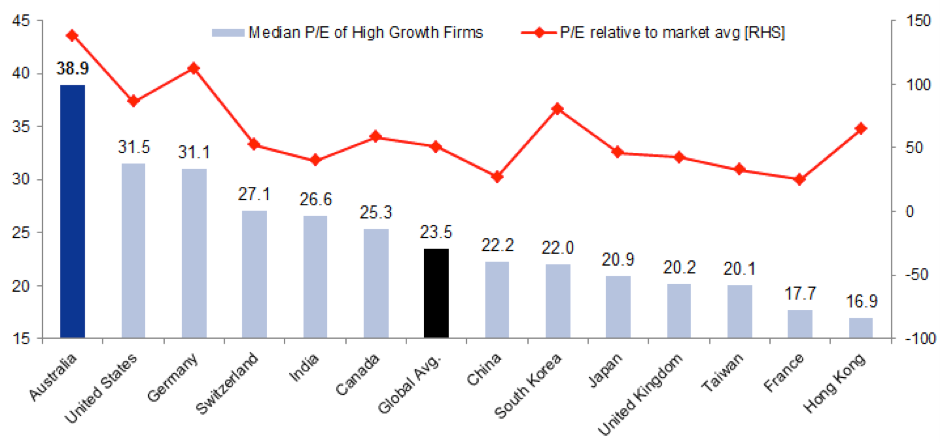With WAAAX stocks slumping almost 10% on Monday’s trading session, the risks of high growth names on the ASX is once again coming to light. WAAAX stocks are a high-flying group of leading ASX growth companies, WiseTech Global (ASX: WTC), Altium Limited (ASX: ALU), Appen Limited (ASX: APX), Afterpay Touch Group (ASX: APT) and Xero Limited (ASX: XRO), that have reignited a low growth domestic market and attracted large amounts of institutional capital.
WAAAX Off! High PE Corrects Most in Market Meltdown.
The group has continued to rally despite some companies within the group recently downgrading earnings or revenue expectations, highlighting broad-based positive market sentiment to the stocks. Nevertheless, since the stocks have such high betas, we would expect them to sell off further if the current market sell-off was sustained.

Figure 1: Australia has the most expensive high PE names (Credit: Livewire)
Why did the WAAAX Stocks get hit so hard?
One view on the WAAAX stocks is that the premium to global peers is unjustified, and a result of funds with ASX 200 mandates paying up for growth in a value-oriented domestic market. Others believe that non-quantitative factors such as quality management, strong pricing power, and competitive moats justify the earnings premium to international peers. The latter group would also argue that the limited number of growth stocks on the local index presents a restrictive sample size that makes a comparison with global peers unwise.
The alternative view of the WAAAX stocks is that the market is hitting euphoric levels on the back of sky-high optimism towards the tech sector, in addition to optimistic speculators who are happy to pay for several years of earnings growth upfront. They would argue that the sector is ripe for a correction, given that the average forward PE ratio has more than tripled over the past two years alone, to reach a level around 100. These investors point to countless other examples like the Dot com bubble and the Nifty Fifty, which ended in tears for investors.
What both groups of investors would agree on, however, is that WAAAX stocks are far more volatile than the broader market. Last December, when the broader market was down almost 20%, most stocks in the WAAAX group were down around 50%. Investors who buy the businesses with a shorter-term horizon would do well to analyse those businesses in the context of the economy and stock market.
One reason for the volatility of WAAAX stocks is the inclusion of barely profitable/ pre-earnings businesses such as Afterpay. Some analysts believe that Afterpay’s concentration amongst creditors with poor borrowing track records make the company like typical sub-prime credit providers. Sub-prime credit performed particularly poorly in the GFC, and many investors do not believe that Afterpay’s investments in AI and unique credit analytics processes will be able to save the company from the same fate. Others disagree however and believe that Afterpay’s low default rate and small loan sizes will reduce non-compliance, given that borrowers would not want to trade a good credit rating for a few hundred dollars.
Xero and Altium both outperformed the WAAAX group on Monday’s trading session, reflecting their more reasonable multiples and strong cash flows. They are also viewed by the market as quality businesses, which generally helps protect companies from selloffs. We saw that in the GFC with CSL Limited (ASX:CSL), a high multiple ASX pharmaceutical business that corrected 25% against a steep market selloff where the ASX 200 more than halved.
Disclaimer:
This article has been prepared by the Australian Stock Report Pty Ltd (AFSL: 301 682. ABN: 94 106 863 978) (“ASR”). ASR is part of Amalgamated Australian Investment Group Limited (AAIG) (ABN: 81 140 208 288 Level 13, 130 Pitt Street, Sydney NSW 2000).
This article is provided for informational purpose only and does not purport to contain all matters relevant to any particular investment or financial instrument. Any market commentary in this communication is not intended to constitute “research” as defined by applicable regulations. Whilst information published on or accessed via this website is believed to be reliable, as far as permitted by law we make no representations as to its ongoing availability, accuracy or completeness. Any quotes or prices used herein are current at the time of preparation. This document and its contents are proprietary information and products of our firm and may not be reproduced or otherwise disseminated in whole or in part without our written consent unless required to by judicial or administrative proceeding. The ultimate decision to proceed with any transaction rests solely with you. We are not acting as your advisor in relation to any information contained herein. Any projections are estimates only and may not be realised in the future.

















